
Illustrative Math Alignment: Grade 6 Unit 8
Data Sets and Distributions
Lesson 18: Using Data to Solve Problems
Use the following Media4Math resources with this Illustrative Math lesson.
| Thumbnail Image | Title | Body | Curriculum Nodes |
|---|---|---|---|
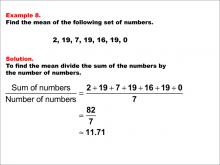
|
Math Example--Measures of Central Tendency--Mean: Example 8 | Math Example--Measures of Central Tendency--Mean: Example 8TopicMeasures of Central Tendency DescriptionThis example demonstrates the calculation of the mean for a set of numbers: 2, 19, 7, 19, 16, 19, and 0. The process involves summing all values and dividing by the count of numbers, resulting in an average of approximately 11.71. This example reinforces the concept of finding a central value that represents the entire dataset. |
Data Analysis |
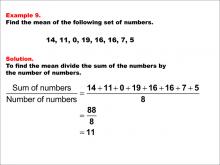
|
Math Example--Measures of Central Tendency--Mean: Example 9 | Math Example--Measures of Central Tendency--Mean: Example 9TopicMeasures of Central Tendency DescriptionThis example illustrates the calculation of the mean for the numbers 14, 11, 0, 19, 16, 16, 7, and 5. The process involves summing all values (88) and dividing by the count of numbers (8), resulting in a mean of 11. This example showcases how the mean can provide a central value that represents a diverse set of numbers, including zero. |
Data Analysis |
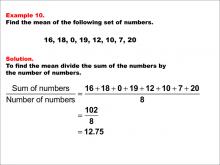
|
Math Example--Measures of Central Tendency--Mean: Example 10 | Math Example--Measures of Central Tendency--Mean: Example 10TopicMeasures of Central Tendency DescriptionThis example demonstrates the calculation of the mean for the numbers 16, 18, 0, 19, 12, 10, 7, and 20. The process involves summing all values (102) and dividing by the count of numbers (8), resulting in a mean of 12.75. This example highlights how the mean can provide a representative value for a dataset that includes both high and low numbers, including zero. |
Data Analysis |
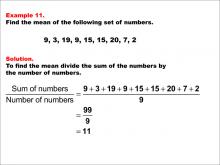
|
Math Example--Measures of Central Tendency--Mean: Example 11 | Math Example--Measures of Central Tendency--Mean: Example 11TopicMeasures of Central Tendency DescriptionThis example illustrates the calculation of the mean for the numbers 9, 3, 19, 9, 15, 15, 20, 7, and 2. The process involves summing all values (99) and dividing by the count of numbers (9), resulting in a mean of 11. This example demonstrates how the mean can provide a central value that represents a dataset with repeated numbers and a wide range of values. |
Data Analysis |
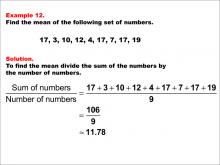
|
Math Example--Measures of Central Tendency--Mean: Example 12 | Math Example--Measures of Central Tendency--Mean: Example 12TopicMeasures of Central Tendency DescriptionThis example demonstrates the calculation of the mean for the numbers 17, 3, 10, 12, 4, 17, 7, 17, and 19. The process involves summing all values (106) and dividing by the count of numbers (9), resulting in a mean of approximately 11.78. This example showcases how the mean can provide a representative value for a dataset that includes repeated numbers and a wide range of values. |
Data Analysis |
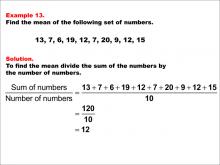
|
Math Example--Measures of Central Tendency--Mean: Example 13 | Math Example--Measures of Central Tendency--Mean: Example 13TopicMeasures of Central Tendency DescriptionThis example illustrates the calculation of the mean for the numbers 13, 7, 6, 19, 12, 7, 20, 9, 12, and 15. The process involves summing all values (120) and dividing by the count of numbers (10), resulting in a mean of 12. This example demonstrates how the mean can provide a central value that represents a dataset with repeated numbers and a wide range of values. |
Data Analysis |

|
Math Example--Measures of Central Tendency--Mean: Example 14 | Math Example--Measures of Central Tendency--Mean: Example 14TopicMeasures of Central Tendency DescriptionThis example demonstrates the calculation of the mean for the numbers 10, 2, 7, 16, 16, 17, 3, 10, 18, and 15. The process involves summing all values (114) and dividing by the count of numbers (10), resulting in a mean of 11.4. This example showcases how the mean can provide a representative value for a dataset that includes repeated numbers and a wide range of values. |
Data Analysis |
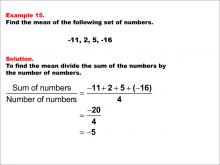
|
Math Example--Measures of Central Tendency--Mean: Example 15 | Math Example--Measures of Central Tendency--Mean: Example 15TopicMeasures of Central Tendency DescriptionThis example illustrates the calculation of the mean for the numbers -11, 2, 5, and -16. The process involves summing all values (-20) and dividing by the count of numbers (4), resulting in a mean of -5. This example is particularly important as it demonstrates how to handle negative numbers when calculating the mean, a concept that often challenges students. |
Data Analysis |
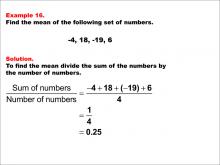
|
Math Example--Measures of Central Tendency--Mean: Example 16 | Math Example--Measures of Central Tendency--Mean: Example 16TopicMeasures of Central Tendency DescriptionThis example demonstrates the calculation of the mean for the numbers -4, 18, -19, and 6. The process involves summing all values (1) and dividing by the count of numbers (4), resulting in a mean of 0.25. This example is particularly interesting as it shows how positive and negative numbers can nearly balance each other out, resulting in a mean close to zero. |
Data Analysis |
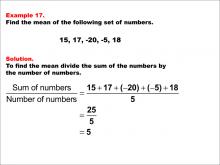
|
Math Example--Measures of Central Tendency--Mean: Example 17 | Math Example--Measures of Central Tendency--Mean: Example 17TopicMeasures of Central Tendency DescriptionThis example illustrates the calculation of the mean for the numbers 15, 17, -20, -5, and 18. The process involves summing all values (25) and dividing by the count of numbers (5), resulting in a mean of 5. This example is particularly instructive as it demonstrates how to handle a mix of positive and negative numbers, including some relatively large values in both directions. |
Data Analysis |
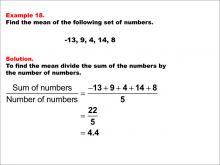
|
Math Example--Measures of Central Tendency--Mean: Example 18 | Math Example--Measures of Central Tendency--Mean: Example 18TopicMeasures of Central Tendency DescriptionThis example demonstrates the calculation of the mean for the numbers -13, 9, 4, 14, and 8. The process involves summing all values (22) and dividing by the count of numbers (5), resulting in a mean of 4.4. This example is particularly instructive as it shows how a single negative number can significantly impact the mean, even when most of the numbers are positive. |
Data Analysis |
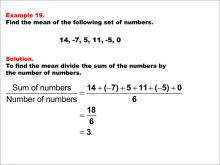
|
Math Example--Measures of Central Tendency--Mean: Example 19 | Math Example--Measures of Central Tendency--Mean: Example 19TopicMeasures of Central Tendency DescriptionThis example illustrates the calculation of the mean for the numbers 14, -7, 5, 11, -5, and 0. The process involves summing all values (18) and dividing by the count of numbers (6), resulting in a mean of 3. This example is particularly instructive as it demonstrates how to handle a mix of positive and negative numbers, including zero, in the calculation of the mean. |
Data Analysis |
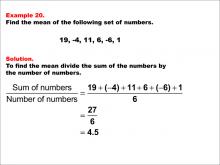
|
Math Example--Measures of Central Tendency--Mean: Example 20 | Math Example--Measures of Central Tendency--Mean: Example 20TopicMeasures of Central Tendency DescriptionThis example demonstrates the calculation of the mean for the numbers 19, -4, 11, 6, -6, and 1. The process involves summing all values (27) and dividing by the count of numbers (6), resulting in a mean of 4.5. This example is particularly instructive as it shows how positive and negative numbers interact in the calculation of the mean, resulting in a positive value despite the presence of negative numbers. |
Data Analysis |
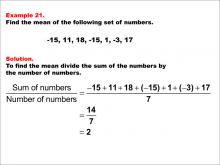
|
Math Example--Measures of Central Tendency--Mean: Example 21 | Math Example--Measures of Central Tendency--Mean: Example 21TopicMeasures of Central Tendency DescriptionThis example illustrates the calculation of the mean for the numbers -15, 11, 18, -15, 1, -3, and 17. The process involves summing all values (14) and dividing by the count of numbers (7), resulting in a mean of 2. This example is particularly instructive as it demonstrates how to handle a mix of positive and negative numbers, including repeated values, in the calculation of the mean. |
Data Analysis |
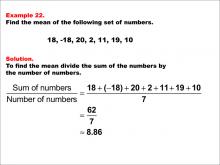
|
Math Example--Measures of Central Tendency--Mean: Example 22 | Math Example--Measures of Central Tendency--Mean: Example 22TopicMeasures of Central Tendency DescriptionThis example demonstrates the calculation of the mean for the numbers 18, -18, 20, 2, 11, 19, and 10. The process involves summing all values (62) and dividing by the count of numbers (7), resulting in a mean of approximately 8.86. This example is particularly instructive as it shows how a single large negative number can significantly impact the mean, even when most of the numbers are positive. |
Data Analysis |
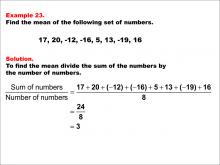
|
Math Example--Measures of Central Tendency--Mean: Example 23 | Math Example--Measures of Central Tendency--Mean: Example 23TopicMeasures of Central Tendency DescriptionThis example illustrates the calculation of the mean for the numbers 17, 20, -12, -16, 5, 13, -19, and 16. The process involves summing all values (24) and dividing by the count of numbers (8), resulting in a mean of 3. This example is particularly instructive as it demonstrates how to handle a mix of positive and negative numbers with varying magnitudes in the calculation of the mean. |
Data Analysis |
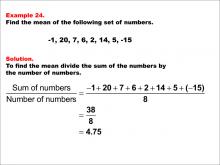
|
Math Example--Measures of Central Tendency--Mean: Example 24 | Math Example--Measures of Central Tendency--Mean: Example 24TopicMeasures of Central Tendency DescriptionThis example demonstrates the calculation of the mean for the numbers -1, 20, 7, 6, 2, 14, 5, and -15. The process involves summing all values (38) and dividing by the count of numbers (8), resulting in a mean of 4.75. This example is particularly instructive as it shows how a mix of positive and negative numbers, including some relatively large values in both directions, can interact to produce a mean that doesn't necessarily reflect the magnitude of the largest numbers in the set. |
Data Analysis |
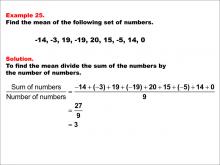
|
Math Example--Measures of Central Tendency--Mean: Example 25 | Math Example--Measures of Central Tendency--Mean: Example 25TopicMeasures of Central Tendency DescriptionThis example illustrates the calculation of the mean for the numbers -14, -3, 19, -19, 20, 15, -5, 14, and 0. The process involves summing all values (27) and dividing by the count of numbers (9), resulting in a mean of 3. This example is particularly instructive as it demonstrates how to handle a mix of positive and negative numbers, including zero, in the calculation of the mean. |
Data Analysis |
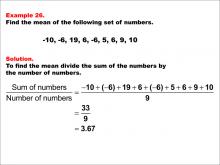
|
Math Example--Measures of Central Tendency--Mean: Example 26 | Math Example--Measures of Central Tendency--Mean: Example 26TopicMeasures of Central Tendency DescriptionThis example demonstrates the calculation of the mean for the numbers -10, -6, 19, 6, -6, 5, 6, 9, and 10. The process involves summing all values (33) and dividing by the count of numbers (9), resulting in a mean of approximately 3.67. This example is particularly instructive as it shows how positive and negative numbers interact in the calculation of the mean, resulting in a positive value despite the presence of negative numbers. |
Data Analysis |

|
Math Example--Measures of Central Tendency--Mean: Example 27 | Math Example--Measures of Central Tendency--Mean: Example 27TopicMeasures of Central Tendency DescriptionThis example illustrates the calculation of the mean for the numbers 10, -14, 14, 17, 20, -3, -20, -2, 11, and -3. The process involves summing all values (30) and dividing by the count of numbers (10), resulting in a mean of 3. This example is particularly instructive as it demonstrates how to handle a mix of positive and negative numbers, including some relatively large values in both directions, in the calculation of the mean. |
Data Analysis |
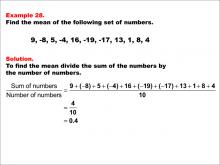
|
Math Example--Measures of Central Tendency--Mean: Example 28 | Math Example--Measures of Central Tendency--Mean: Example 28TopicMeasures of Central Tendency DescriptionThis example demonstrates the calculation of the mean for the numbers 9, -8, 5, -4, 16, -19, -17, 13, 1, 8, and 4. The process involves summing all values (4) and dividing by the count of numbers (10), resulting in a mean of 0.4. This example is particularly instructive as it shows how a mix of positive and negative numbers, including some relatively large values in both directions, can interact to produce a mean close to zero. |
Data Analysis |
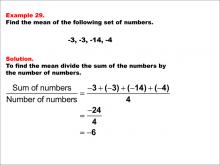
|
Math Example--Measures of Central Tendency--Mean: Example 29 | Math Example--Measures of Central Tendency--Mean: Example 29TopicMeasures of Central Tendency DescriptionThis example illustrates the calculation of the mean for the numbers -3, -3, -14, and -4. The process involves summing all values (-24) and dividing by the count of numbers (4), resulting in a mean of -6. This example is particularly instructive as it demonstrates how to handle a dataset consisting entirely of negative numbers in the calculation of the mean. |
Data Analysis |
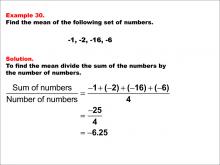
|
Math Example--Measures of Central Tendency--Mean: Example 30 | Math Example--Measures of Central Tendency--Mean: Example 30TopicMeasures of Central Tendency DescriptionThis example demonstrates the calculation of the mean for the numbers -1, -2, -16, and -6. The process involves summing all values (-25) and dividing by the count of numbers (4), resulting in a mean of -6.25. This example is particularly instructive as it shows how to handle a dataset consisting entirely of negative numbers, including one significantly larger negative value, in the calculation of the mean. |
Data Analysis |
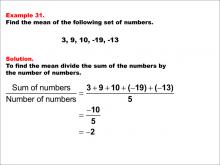
|
Math Example--Measures of Central Tendency--Mean: Example 31 | Math Example--Measures of Central Tendency--Mean: Example 31TopicMeasures of Central Tendency DescriptionThis example illustrates the calculation of the mean for the numbers 3, 9, 10, -19, and -13. The process involves summing all values (-10) and dividing by the count of numbers (5), resulting in a mean of -2. This example is particularly instructive as it demonstrates how to handle a mix of positive and negative numbers, including some relatively large values in both directions, in the calculation of the mean. |
Data Analysis |

|
Math Example--Measures of Central Tendency--Mean: Example 32 | Math Example--Measures of Central Tendency--Mean: Example 32TopicMeasures of Central Tendency DescriptionThis example demonstrates the calculation of the mean for a set of numbers. The process involves summing all values and dividing by the count of numbers. This example is particularly instructive as it reinforces the concept of finding a central value that represents the entire dataset, even when dealing with a mix of positive and negative numbers. |
Data Analysis |
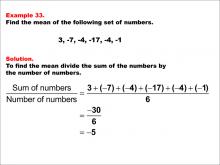
|
Math Example--Measures of Central Tendency--Mean: Example 33 | Math Example--Measures of Central Tendency--Mean: Example 33TopicMeasures of Central Tendency DescriptionThis example illustrates the calculation of the mean for another set of numbers. The process involves summing all values and dividing by the count of numbers. This example is particularly instructive as it continues to reinforce the concept of finding a central value that represents the entire dataset, potentially dealing with a different range or distribution of numbers than previous examples. |
Data Analysis |
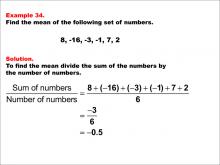
|
Math Example--Measures of Central Tendency--Mean: Example 34 | Math Example--Measures of Central Tendency--Mean: Example 34TopicMeasures of Central Tendency DescriptionThis example demonstrates the calculation of the mean for yet another set of numbers. The process involves summing all values and dividing by the count of numbers. This example is particularly instructive as it continues to reinforce the concept of finding a central value that represents the entire dataset, potentially dealing with a different range or distribution of numbers than previous examples. |
Data Analysis |
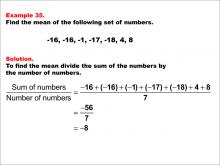
|
Math Example--Measures of Central Tendency--Mean: Example 35 | Math Example--Measures of Central Tendency--Mean: Example 35TopicMeasures of Central Tendency DescriptionThis example illustrates the calculation of the mean for a new set of numbers. The process involves summing all values and dividing by the count of numbers. This example is particularly instructive as it continues to reinforce the concept of finding a central value that represents the entire dataset, potentially dealing with a different range or distribution of numbers than previous examples. |
Data Analysis |
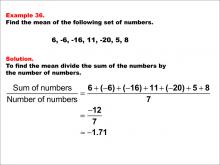
|
Math Example--Measures of Central Tendency--Mean: Example 36 | Math Example--Measures of Central Tendency--Mean: Example 36TopicMeasures of Central Tendency DescriptionThis example demonstrates the calculation of the mean for another set of numbers. The process involves summing all values and dividing by the count of numbers. This example is particularly instructive as it continues to reinforce the concept of finding a central value that represents the entire dataset, potentially dealing with a different range or distribution of numbers than previous examples. |
Data Analysis |

|
Math Example--Measures of Central Tendency--Mean: Example 37 | Math Example--Measures of Central Tendency--Mean: Example 37TopicMeasures of Central Tendency DescriptionThis example illustrates the calculation of the mean for a new set of numbers. The process involves summing all values and dividing by the count of numbers. This example is particularly instructive as it continues to reinforce the concept of finding a central value that represents the entire dataset, potentially dealing with a different range or distribution of numbers than previous examples. |
Data Analysis |

|
Math Example--Measures of Central Tendency--Mean: Example 38 | Math Example--Measures of Central Tendency--Mean: Example 38TopicMeasures of Central Tendency DescriptionThis example demonstrates the calculation of the mean for a set of numbers. The process involves summing all values and dividing by the count of numbers. This example is particularly instructive as it reinforces the concept of finding a central value that represents the entire dataset, potentially dealing with a different range or distribution of numbers than previous examples. |
Data Analysis |
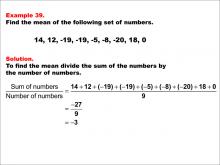
|
Math Example--Measures of Central Tendency--Mean: Example 39 | Math Example--Measures of Central Tendency--Mean: Example 39TopicMeasures of Central Tendency DescriptionThis example illustrates the calculation of the mean for a new set of numbers. The process involves summing all values and dividing by the count of numbers. This example is particularly instructive as it continues to reinforce the concept of finding a central value that represents the entire dataset, potentially dealing with a different range or distribution of numbers than previous examples. |
Data Analysis |
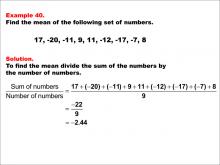
|
Math Example--Measures of Central Tendency--Mean: Example 40 | Math Example--Measures of Central Tendency--Mean: Example 40TopicMeasures of Central Tendency DescriptionThis example demonstrates the calculation of the mean for another set of numbers. The process involves summing all values and dividing by the count of numbers. This example is particularly instructive as it continues to reinforce the concept of finding a central value that represents the entire dataset, potentially dealing with a different range or distribution of numbers than previous examples. |
Data Analysis |
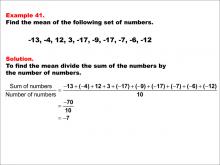
|
Math Example--Measures of Central Tendency--Mean: Example 41 | Math Example--Measures of Central Tendency--Mean: Example 41TopicMeasures of Central Tendency DescriptionThis example illustrates the calculation of the mean for a new set of numbers. The process involves summing all values and dividing by the count of numbers. This example is particularly instructive as it continues to reinforce the concept of finding a central value that represents the entire dataset, potentially dealing with a different range or distribution of numbers than previous examples. |
Data Analysis |
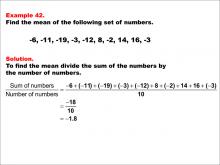
|
Math Example--Measures of Central Tendency--Mean: Example 42 | Math Example--Measures of Central Tendency--Mean: Example 42TopicMeasures of Central Tendency DescriptionThis example demonstrates the calculation of the mean for another set of numbers. The process involves summing all values and dividing by the count of numbers. This example is particularly instructive as it continues to reinforce the concept of finding a central value that represents the entire dataset, potentially dealing with a different range or distribution of numbers than previous examples. |
Data Analysis |

|
Math Example--Measures of Central Tendency--Median: Example 1 | Math Example--Measures of Central Tendency--Median: Example 1TopicMeasures of Central Tendency DescriptionThis example demonstrates how to find the median of a set of numbers: 14, 35, 37, 28, 38, 28, 14, 12. The process involves arranging the numbers in ascending order and identifying the middle value. In this case, with an even number of terms, the median is calculated by finding the average of the two middle terms, resulting in a median of 28. |
Data Analysis |
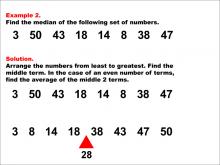
|
Math Example--Measures of Central Tendency--Median: Example 2 | Math Example--Measures of Central Tendency--Median: Example 2TopicMeasures of Central Tendency DescriptionThis example illustrates the process of finding the median for the set of numbers: 3, 50, 43, 18, 14, 8, 38, 47. The solution involves arranging the numbers from least to greatest and then identifying the middle value. With an even number of terms, the median is calculated as the average of the two middle terms, resulting in a median of 28. |
Data Analysis |
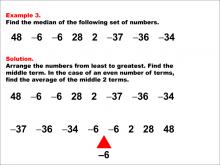
|
Math Example--Measures of Central Tendency--Median: Example 3 | Math Example--Measures of Central Tendency--Median: Example 3TopicMeasures of Central Tendency DescriptionThis example demonstrates finding the median of the following set of numbers: 48, -6, -6, 28, 2, -37, -36, -34. The solution involves arranging the numbers from least to greatest and then identifying the middle value. With an even number of terms, the median is calculated as the average of the two middle terms, resulting in a median of -6. |
Data Analysis |

|
Math Example--Measures of Central Tendency--Median: Example 4 | Math Example--Measures of Central Tendency--Median: Example 4TopicMeasures of Central Tendency DescriptionThis example illustrates the process of finding the median for the set of numbers: 13, -20, 4, -4, -43, 46, -17, -19. The solution involves arranging the numbers from least to greatest and then identifying the middle value. With an even number of terms, the median is calculated as the average of the two middle terms, resulting in a median of -10/5 or -2. |
Data Analysis |

|
Math Example--Measures of Central Tendency--Median: Example 5 | Math Example--Measures of Central Tendency--Median: Example 5TopicMeasures of Central Tendency DescriptionThis example demonstrates how to find the median of the following set of numbers: 49, 3, 27, 46, 7, 32, 21, 33, 33. The process involves arranging the numbers from least to greatest and then identifying the middle value. In this case, with an odd number of terms, the median is simply the middle number after sorting, which is 32. |
Data Analysis |
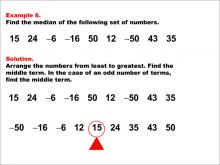
|
Math Example--Measures of Central Tendency--Median: Example 6 | Math Example--Measures of Central Tendency--Median: Example 6TopicMeasures of Central Tendency DescriptionThis example illustrates the process of finding the median for the set of numbers: 15, 24, -6, -16, 50, 12, -50, 43, 35. The solution involves arranging the numbers from least to greatest and then identifying the middle value. With an odd number of terms, the median is simply the middle number after sorting, which in this case is 15. |
Data Analysis |
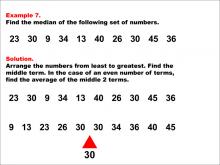
|
Math Example--Measures of Central Tendency--Median: Example 7 | Math Example--Measures of Central Tendency--Median: Example 7TopicMeasures of Central Tendency DescriptionThis example demonstrates finding the median of the following set of numbers: 23, 30, 9, 34, 13, 40, 26, 30, 45, 36. The solution involves arranging the numbers from least to greatest and then identifying the middle value. With an even number of terms, the median is calculated as the average of the two middle terms, resulting in a median of 30. |
Data Analysis |
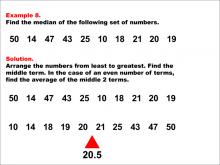
|
Math Example--Measures of Central Tendency--Median: Example 8 | Math Example--Measures of Central Tendency--Median: Example 8TopicMeasures of Central Tendency DescriptionThis example demonstrates how to find the median of the following set of numbers: 50, 14, 47, 43, 25, 10, 18, 21, 20, 19. The process involves arranging the numbers in ascending order and then identifying the middle value. With an even number of terms, the median is calculated as the average of the two middle terms, resulting in a median of 20.5. |
Data Analysis |

|
Math Example--Measures of Central Tendency--Median: Example 9 | Math Example--Measures of Central Tendency--Median: Example 9TopicMeasures of Central Tendency DescriptionThis example illustrates the process of finding the median for the set of numbers: 13, -3, 23, -20, -14, -32, -31, -21, 36, -14. The solution involves arranging the numbers from least to greatest and then identifying the middle value. With an even number of terms, the median is calculated as the average of the two middle terms, resulting in a median of -14. |
Data Analysis |
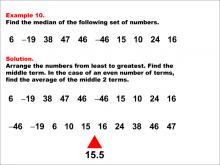
|
Math Example--Measures of Central Tendency--Median: Example 10 | Math Example--Measures of Central Tendency--Median: Example 10TopicMeasures of Central Tendency DescriptionThis example demonstrates finding the median of the following set of numbers: 6, -19, 38, 47, 46, -46, 15, 10, 24, 16. The solution involves arranging the numbers from least to greatest and then identifying the middle value. With an even number of terms, the median is calculated as the average of the two middle terms, resulting in a median of 15.5. |
Data Analysis |
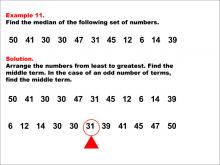
|
Math Example--Measures of Central Tendency--Median: Example 11 | Math Example--Measures of Central Tendency--Median: Example 11TopicMeasures of Central Tendency DescriptionThis example illustrates the process of finding the median for the set of numbers: 50, 41, 30, 30, 47, 31, 45, 12, 6, 14, 39. The solution involves arranging the numbers from least to greatest and then identifying the middle value. With an odd number of terms, the median is simply the middle number after sorting, which is 31. |
Data Analysis |
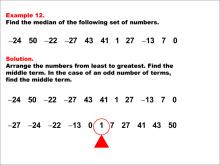
|
Math Example--Measures of Central Tendency--Median: Example 12 | Math Example--Measures of Central Tendency--Median: Example 12TopicMeasures of Central Tendency DescriptionThis example demonstrates finding the median of the following set of numbers: -24, 50, -22, -27, 43, 41, 1, 27, -13, 7, 0. The solution involves arranging the numbers from least to greatest and then identifying the middle value. With an odd number of terms, the median is simply the middle number after sorting, which is 1. |
Data Analysis |
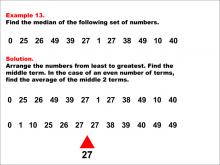
|
Math Example--Measures of Central Tendency--Median: Example 13 | Math Example--Measures of Central Tendency--Median: Example 13TopicMeasures of Central Tendency DescriptionThis example illustrates the process of finding the median for the set of numbers: 0, 25, 26, 49, 39, 27, 1, 27, 38, 49, 10, 40. The solution involves arranging the numbers from least to greatest and then identifying the middle value. With an even number of terms, the median is calculated as the average of the two middle terms, resulting in a median of 27. |
Data Analysis |

|
Math Example--Measures of Central Tendency--Median: Example 14 | Math Example--Measures of Central Tendency--Median: Example 14TopicMeasures of Central Tendency DescriptionThis example demonstrates finding the median of the following set of numbers: 45, 2, 20, 2, 37, 11, 46, 49, 21, 27, 50, 45. The solution involves arranging the numbers from least to greatest and then identifying the middle value. With an even number of terms, the median is calculated as the average of the two middle terms, resulting in a median of 32. |
Data Analysis |
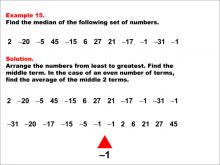
|
Math Example--Measures of Central Tendency--Median: Example 15 | Math Example--Measures of Central Tendency--Median: Example 15TopicMeasures of Central Tendency DescriptionThis example illustrates the process of finding the median for the set of numbers: 2, -20, -5, 45, -15, 6, 27, 21, -17, -1, -31, -1. The solution involves arranging the numbers from least to greatest and then identifying the middle value. With an even number of terms, the median is calculated as the average of the two middle terms, resulting in a median of -1. |
Data Analysis |